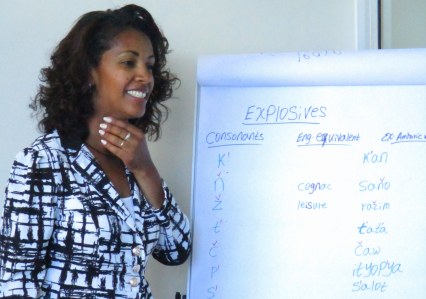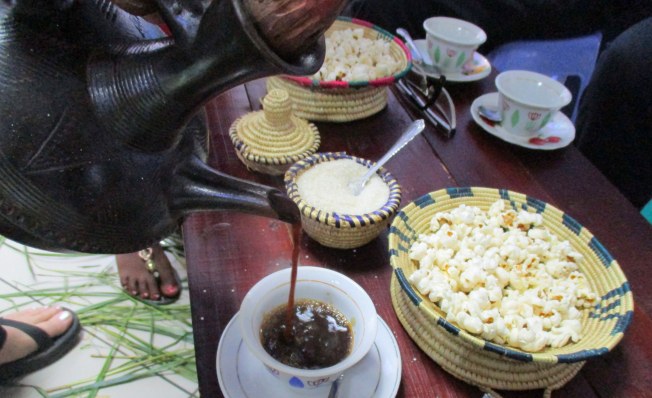 Swahili, which I tried to learn during my short time in Tanzania, is easy peasy compared to Amharic, the official working language of Ethiopia.
Swahili, which I tried to learn during my short time in Tanzania, is easy peasy compared to Amharic, the official working language of Ethiopia.
It’s kind of like chicken, rice, beans and spinach…versus multiple stews with complex ingredients that may or may not include meat depending on the fasting schedule, served atop a spongy, sour flatbread called injera that you eat by ripping off pieces, wrapping it around said stew and popping in your mouth in such a manner as to avoid licking your fingers lest you offend others who are sharing the dish. Then there’s the coffee ceremony.
For starters, Amharic has its own writing system called fidel, adapted from Ge’ez. There are 33 consonant symbols with seven variations, according to the vowel that is coupled with them. So already I can’t actually read the words. I have to listen to people and try to replicate what they’re saying, writing it down as it sounds to me because you see, there is no standard translation of Amharic symbols to the Roman characters we use in English.
This, for instance, means Colleen:  I’ve tried to memorize some of the symbols, a mass of lines and squiggles and circles that are somewhere between those Olympic sport pictograms and charm bracelets. I’ve tried equating the image – say a person taking a flying leap – to the sound — ño (read: noooooo!). It is somewhat effective. But tedious. So I stopped.
I’ve tried to memorize some of the symbols, a mass of lines and squiggles and circles that are somewhere between those Olympic sport pictograms and charm bracelets. I’ve tried equating the image – say a person taking a flying leap – to the sound — ño (read: noooooo!). It is somewhat effective. But tedious. So I stopped.
There’s also the challenge of making the glottalized or explosive version of some of the consonants. That means they’re pronounced with a sudden release of air. Amharic has explosives for the p, t and k sounds. We have them in English too – for sounds like p and t – made with air produced by the lungs. However, in Amharic, the k sound is made in the back of the throat. You can see your Adam’s apple bobbing when you do it correctly (as displayed by our teacher, Milky, below). Sort of feels like you’re gasping for air.

One of my favourite explosive sounds is the word for cold: kaz-kaza. It somehow sounds colder than our cold. Another is beka, which means enough! And teff which is said more like t’eff. Damn, it’s satisfying to nail that sound. Disappointing when one does not.
Now when it comes to people’s names, well. They’re almost paralyzingly complicated to remember; I often have to ask 3, 4, 5 times for people to repeat their name. And again the next time I see them. Names I’ve never heard before: Kahssaye, Tesfaye, Firehiwot, Amogne, Zeritu. I only seem to retain the name when I ask what it means: compensation, hope, fruit for life, wise man, seed (also: big expectations set by parents).
The thing to do when you’re learning a language you have no hope of mastering in a short time is to memorize some key words and expressions that make people smile. Words like aHEEya for donkey and WOOsha for dog. Heck they make me smile. And when the coffee is dark brown and tastes good, a zinger like: Ya doro eyne yamasalla bunna – it looks like a chicken’s eye. Because really who doesn’t appreciate the colour of a chicken’s eye? 
There are also the words I have to say almost every day on my commute across Addis Ababa: waraj alleh – there is a stop! It’s said WUH-raj AHHHL-uh, not simply ALLUH, which is such a foreigner pronunciation. The other day it was deathly quiet on the minibus and I was sitting at the back, and you have to yell this out, otherwise the bus keeps hauling along. So I had to screw up my courage and holler: waraj alleh! And the man next to me smiled and congratulated me on my fine pronunciation. My chest puffed with pride.
It’s like when you finally learn how to rip off just enough injera to wrap the stew without touching your fingers to your mouth, using only your right hand, staying within your section, and dabbling in this stew and that stew so you get the perfect blend of spices.
Ishi. It’s all good.